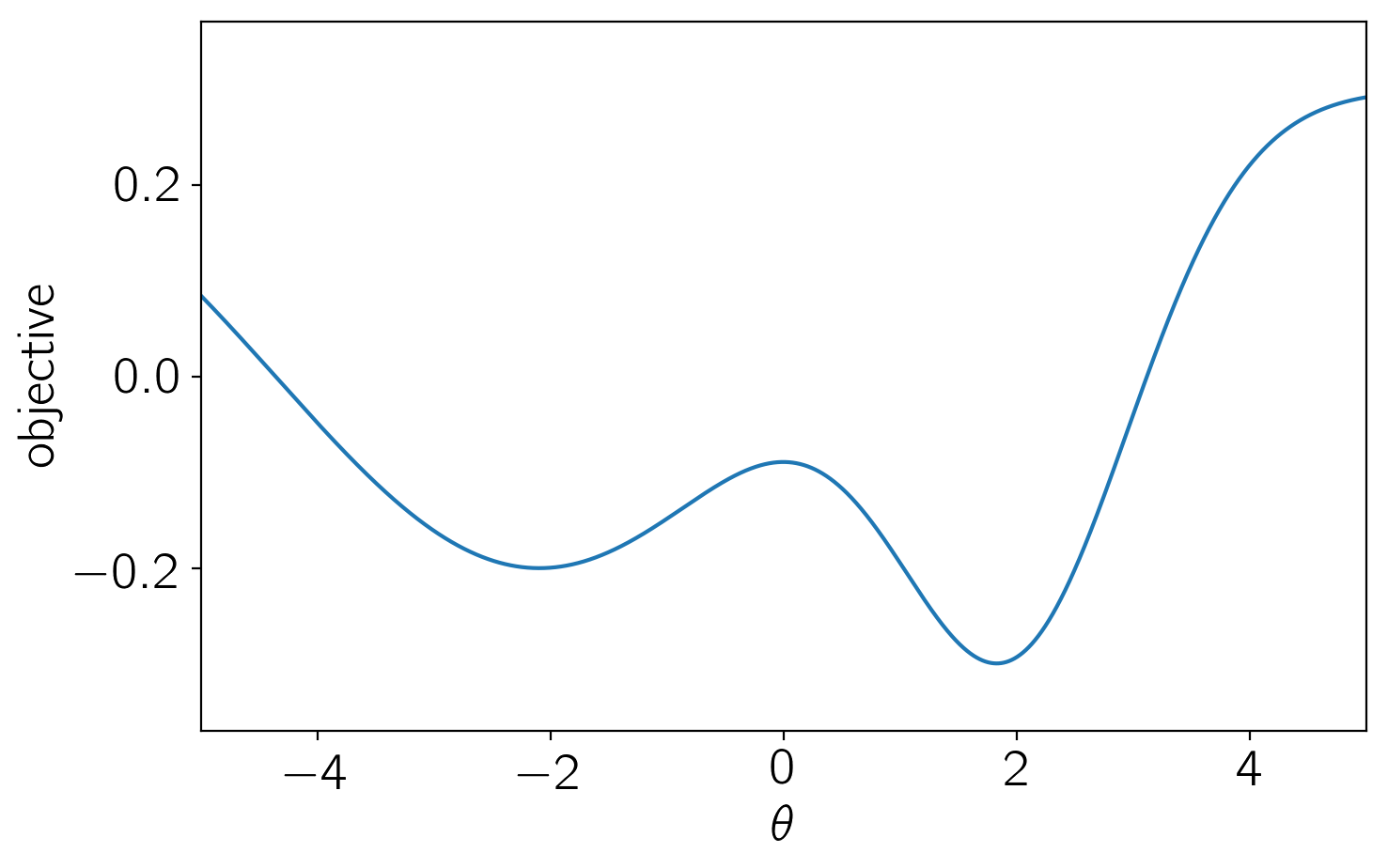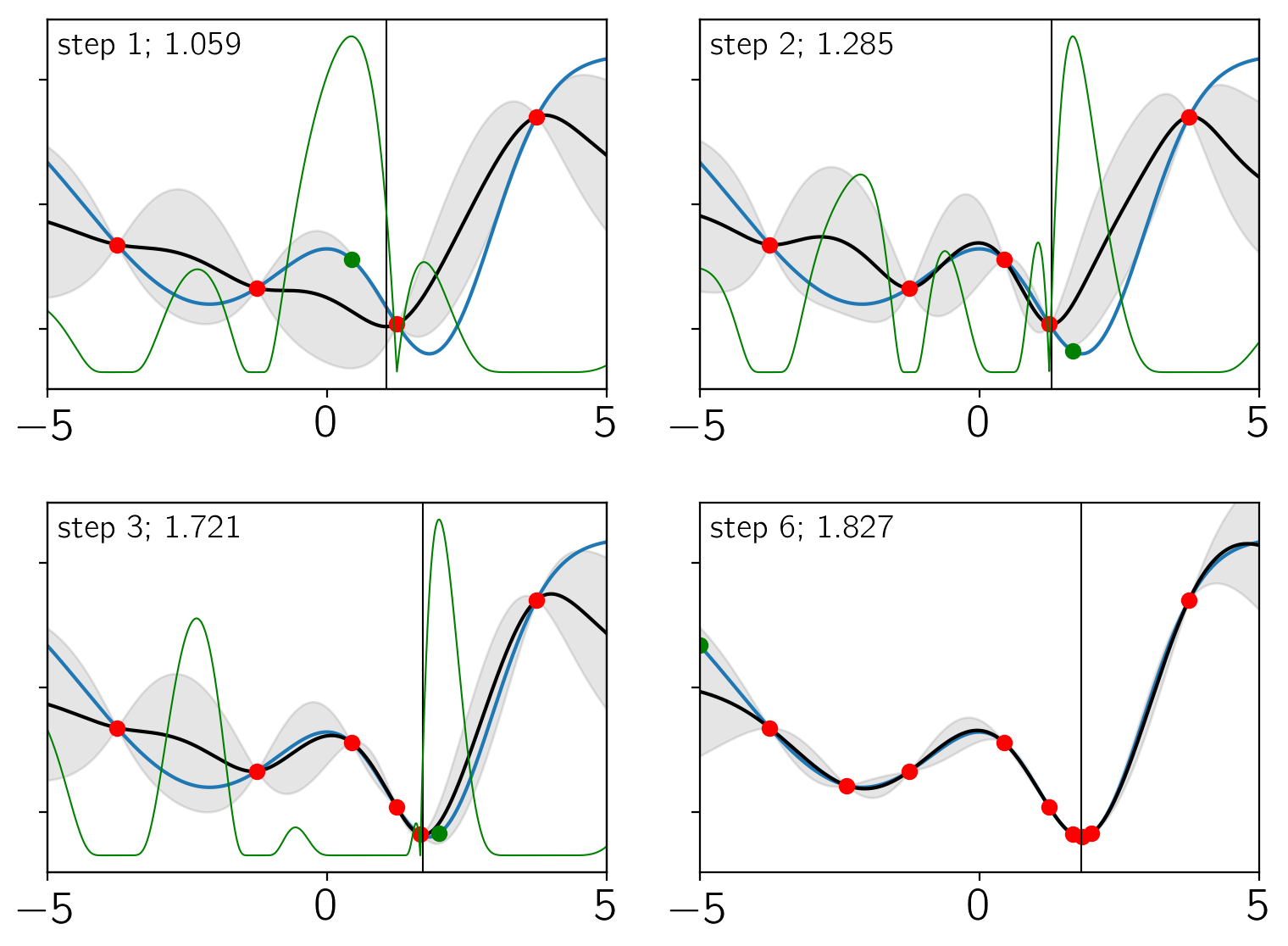Note
This tutorial was generated from an IPython notebook that can be downloaded here.
Bayesian optimization#
This notebook was made with the following version of george:
import george
george.__version__
'0.3.1'
In this tutorial, we’ll show a very simple example of implementing “Bayesian optimization” using george. Now’s not the time to get into a discussion of the issues with the name given to these methods, but I think that the “Bayesian” part of the title comes from the fact that the method relies on the (prior) assumption that the objective function is smooth. The basic idea is that you can reduce the number of function evaluations needed to minimize a black-box function by using a GP as a surrogate model. This can be huge if evaluating your model is computationally expensive. I think that the classic reference is Jones et al. (1998) and the example here will look a bit like their section 4.1.
First, we’ll define the scalar objective, parametrized by \(\theta\), that we want to minimize in the range \(-5 \le \theta \le 5\).
import numpy as np
import matplotlib.pyplot as plt
def objective(theta):
return -0.5 * np.exp(-0.5*(theta - 2)**2) - 0.5 * np.exp(-0.5 * (theta + 2.1)**2 / 5) + 0.3
t = np.linspace(-5, 5, 5000)
plt.figure(figsize=(8, 5))
plt.plot(t, objective(t))
plt.ylim(-0.37, 0.37)
plt.xlim(-5, 5)
plt.xlabel("$\\theta$")
plt.ylabel("objective");

Now, for the “Bayesian” optimization, the basic procedure that we’ll follow is:
Start by evaluating the model at a set of points. In this case, we’ll start with a uniform grid in \(\theta\).
Fit a GP (optimize the hyperparameters) to the set of training points.
Find the input coordinate that maximizes the “expected improvement” (see Section 4 of Jones+ 1998). For simplicity, we simply use a grid search to maximize this, but this should probably be a numerical optimization in any real application of this method.
At this new coordinate, run the model and add this as a new training point.
Return to step 2 until converged. We’ll judge convergence using relative changes in the location of the minimum.
from george import kernels
from scipy.special import erf
from scipy.optimize import minimize
N_init = 4
train_theta = np.linspace(-5, 5, N_init + 1)[1:]
train_theta -= 0.5 * (train_theta[1] - train_theta[0])
train_f = objective(train_theta)
gp = george.GP(np.var(train_f) * kernels.Matern52Kernel(3.0),
fit_mean=True)
gp.compute(train_theta)
def nll(params):
gp.set_parameter_vector(params)
g = gp.grad_log_likelihood(train_f, quiet=True)
return -gp.log_likelihood(train_f, quiet=True), -g
fig, axes = plt.subplots(2, 2, figsize=(8, 6))
j = 0
old_min = None
converged = False
for i in range(1000):
# Update the GP parameters
soln = minimize(nll, gp.get_parameter_vector(), jac=True)
# Compute the acquisition function
mu, var = gp.predict(train_f, t, return_var=True)
std = np.sqrt(var)
f_min = np.min(train_f)
chi = (f_min - mu) / std
Phi = 0.5 * (1.0 + erf(chi / np.sqrt(2)))
phi = np.exp(-0.5 * chi**2) / np.sqrt(2*np.pi*var)
A_ei = (f_min - mu) * Phi + var * phi
A_max = t[np.argmax(A_ei)]
# Add a new point
train_theta = np.append(train_theta, A_max)
train_f = np.append(train_f, objective(train_theta[-1]))
gp.compute(train_theta)
# Estimate the minimum - I'm sure that there's a better way!
i_min = np.argmin(mu)
sl = slice(max(0, i_min - 1), min(len(t), i_min + 2))
ts = t[sl]
D = np.vander(np.arange(len(ts)).astype(float))
w = np.linalg.solve(D, mu[sl])
minimum = ts[0] + (ts[1] - ts[0]) * np.roots(np.polyder(w[::-1]))
# Check convergence
if i > 0 and np.abs((old_min - minimum) / minimum) < 1e-5:
converged = True
old_min = float(minimum[0])
# Make the plots
if converged or i in [0, 1, 2]:
ax = axes.flat[j]
j += 1
ax.plot(t, objective(t))
ax.plot(t, mu, "k")
ax.plot(train_theta[:-1], train_f[:-1], "or")
ax.plot(train_theta[-1], train_f[-1], "og")
ax.fill_between(t, mu+std, mu-std, color="k", alpha=0.1)
if i <= 3:
ax2 = ax.twinx()
ax2.plot(t, A_ei, "g", lw=0.75)
ax2.set_yticks([])
ax.axvline(old_min, color="k", lw=0.75)
ax.set_ylim(-0.37, 0.37)
ax.set_xlim(-5, 5)
ax.set_yticklabels([])
ax.annotate("step {0}; {1:.3f}".format(i+1, old_min), xy=(0, 1),
xycoords="axes fraction", ha="left", va="top",
xytext=(5, -5), textcoords="offset points",
fontsize=14)
if converged:
break
plt.tight_layout()
print("{0} model evaluations".format(len(train_f)))
10 model evaluations

There’s a lot going on in these plots. Each panel shows the results after a certain iteration (indicated in the top left corner of the panel). In each panel:
The blue line is the true objective function.
The black line and gray contours indicate the current estimate of the objective using the GP model.
The green line is the expected improvement.
The red points are the training set.
The green point is the new point that was added at this step.
The vertical black line is the current estimate of the location minimum. This is also indicated in the top left corner of the panel.
As you can see, only 10 model evaluations (including the original
training set) were needed to converge to the correct minimum. In this
simple example, there are certainly other methods that could have easily
been used to minimize this function, but you can imagine that this
method could be useful for cases where objective is very expensive
to compute.